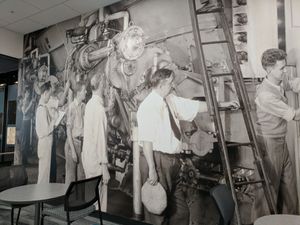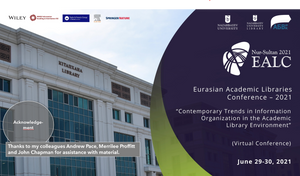I wrote a short piece for Portal last year.
Reconfiguring the Library Systems Environment. portal: Libraries and the Academy, Vol. 8, No. 2, April 2008. // https://www.oclc.org/research/publications/archive/2008/dempsey-portal.pdf (.pdf: 195K/18 pp.) [Lorcan Dempsey: Selected publications [OCLC]]
The introductory remarks about the environment repeat many of the topics discussed in these pages in the last few years:
Think of some of the ways in which the environment that library users operate in has changed in recent years. Behaviors and expectations have been reconfigured in a network environment as more of what people do enters a network space.
- Discovery happens elsewhere: People discover items of interest in a variety of ways: on search engines, in their RSS aggregators, in the resource networks created on social network sites, in consumer recommendations, on collaborative bookmarking sites, in reading and course lists, and so on. Increasingly, we cannot expect users to seek out individual Web sites or resources.
- In the flow: Now that readers and writers increasingly organize their work in network environments, we must build library services around their workflow (or learnflow, or researchflow, or…). This flow is supported by a range of personal tools (RSS aggregators, toolbars, …), network services (Facebook, del.icio.us, …), and by prefabricated workflow support systems (course management systems, for example). Readers and writers expect to work with information resources in those environments, to “gather, create and share.” An important issue here is that the applications that manage the flow (whether it is a social networking site, an RSS aggregator, or a course management system) become the consumers of resources. This creates a demand for machine interfaces: RSS feeds, portlets, Web services, and so on.
- Information is abundant; attention is scarce: As resources, tools, and environments proliferate so does the attention available for any single one of them decline. The implication here for libraries is clear: readers and writers have many choices, so convenience of use is really important.
- Social value and personal value: Scholarly, cultural, and information products are social creations, and their reception is often social. The library model supports this in various ways, but the social aspect of the creation and reception of knowledge has tended to happen outside the library, in the seminar room, the conversation, the review. However, we are now seeing social value created around scholarly and cultural products in network services (think of Flickr, Connotea, LibraryThing, …). Libraries have begun to think about pushing services into social networking sites and adding social networking features to their own services. How do we create social value within library information services?
- The rich get richer–aggregation of supply and demand: Our network experience is characterized by large hubs that exert strong gravitational force on users. Google, Amazon, Realtor.com, eBay, expedia, and so on all aggregate supply. They provide a service that connects a unified discovery experience to multiple fulfillment services; they reduce the effort of getting things done on the network by removing clicks. They also aggregate demand by mobilizing large numbers of users. In this way, hubs provide incentives for both suppliers and consumers to participate; the more users who participate, the more valuable hubs become. I have discussed this dynamic at some length elsewhere in relation to library resources.
- Data works hard: On the network, we shed data about what we do; we leave tracks. The mobilization of this data is now a central part of our Web experience. Services adapt what they do based on what they know about you (such as Amazon recommendations); they create new services by comparing what they know about different people; they provide contribution platforms for data (for example, reviews and recommendations).
These and other factors have radically changed the user and service environment in which libraries operate. Libraries are also working through what it means to offer services in this type of environment. However, a major issue has emerged. The library systems environment was, by and large, shaped before the current period, and it was shaped by different requirements. In the remainder of this brief article, I want to consider that systems environment and suggest some possible directions as we look to better align our capacities to changed circumstances.



